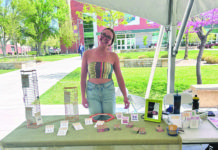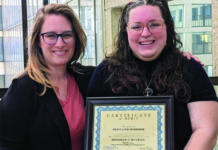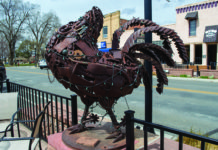The Natural Resources of the West seminar has been around since 2004 and has provided education about environmental topics every year.
“It was started by Dr. Gigi Richard, who was a professor in the geology program. It then grew into a course/seminar that was co-organized by Gigi and Tamera Minnick (former professor in the environmental science program who recently retired). Now, the four professors in the environmental science program co-organize it. This year for the first time CMU’s Water Center is co-organizing, so there is an emphasis on water-related topics,” Professor of Environmental Science Deborah Kennard said.
The class is open to everyone, including the general public. Each week, there is a different speaker that informs the audience about their area of study or work. The goal of this is to provide education on environmental phenomena that affect the west and insight into different paths within the field.
“Natural Resources of the West has made me aware of current environmental issues and areas of research. As someone who is not from the West, it has helped me understand this area better. I definitely feel more familiar with current and future challenges the west may be facing,” junior in environmental science Elena Hromadka said.
Recently, Assistant Professor of Environmental Science Justin Pomeranz invited a speaker based on his work with polluted and degraded streams.
Pomeranz chose Lead Geomorphologist for Anabranch Solutions, LLC Scott Shahverdian to speak about how low-tech process-based restoration (LTPBR) works. His field of fluvial geomorphology is the study of river processes and forms-essentially how rivers shape the earth. Shahverdian uses his expertise in this field to restore rivers and streams.
LTPBR is meant to initiate or accelerate natural hydrology by using simple, hand-built structures such as beaver dam analogs (BDAs) to help streams. Shahverdian and his team will go into sites and build structures inspired by beaver dams with willow, sagebrush, juniper, and untreated wood posts. BDAs improve water quality by trapping sediment in the ponds created by their dams, and by slowing water flows during spring snowmelt and monsoons.

“A large part of our program is teaching students about restoring or rehabilitating damaged or degraded ecosystems. Beaver dam analogs are a low-cost way to restore degraded streams that have the added benefit of making streams and the surrounding riparian areas better able to deal with a future of hotter drier conditions. [The BDAs] are key climate change adaptation tools. And, who wouldn’t want a summer job wading in streams and making little dams out of mud and sticks?” Kennard said.
Shahverdian stated that LTPBR approaches can be effective in areas that are hard to reach and should be used instead of big, heavy machinery. The benefits of these structures are that they have a low impact on the surrounding environment while improving the condition of the body of water it is in.
“My favorite part of the beaver dam analog lecture was learning that we can mimic the effect that beavers have on an ecosystem without reintroducing beavers. It’s even possible to introduce beavers later on after the analog dams have been built,” Hromadka said.
These seminars occur every Wednesday at 4 p.m. and can go to 5 p.m. or later, based on the length of the presentation the guest speaker has prepared. There is no prerequisite for the class, so any student can enroll.
“We encourage students outside of our major to take this seminar next spring. Grades are based on attendance and completing a reflection on each speaker’s seminar. Speakers will change each year. It’s a great way to learn about topics outside of your major!” Kennard said.






